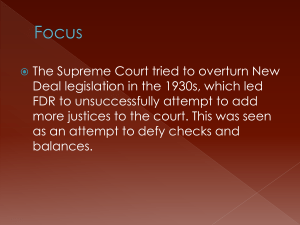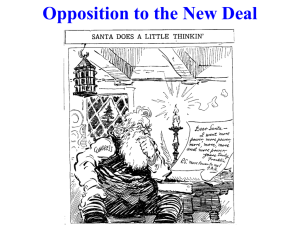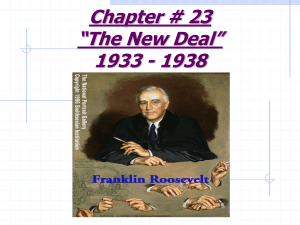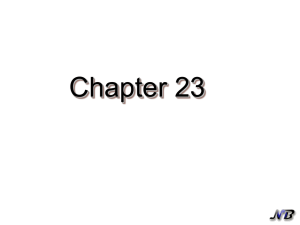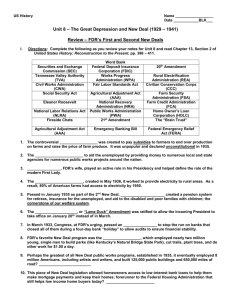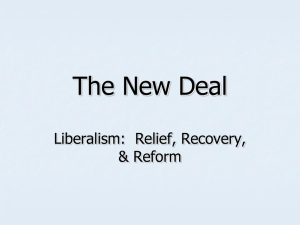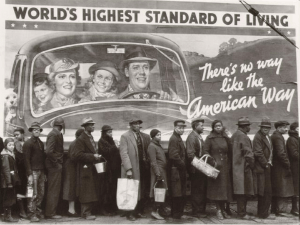Lecture 14–The New Deal - Lone Star College System
advertisement
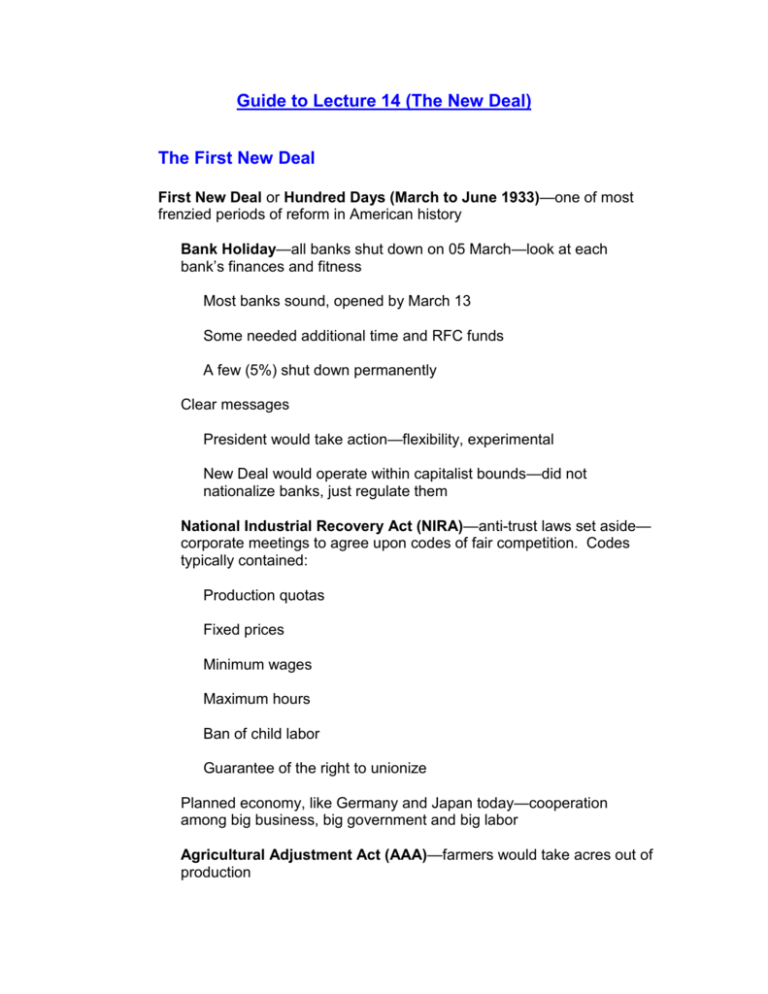
Guide to Lecture 14 (The New Deal) The First New Deal First New Deal or Hundred Days (March to June 1933)—one of most frenzied periods of reform in American history Bank Holiday—all banks shut down on 05 March—look at each bank’s finances and fitness Most banks sound, opened by March 13 Some needed additional time and RFC funds A few (5%) shut down permanently Clear messages President would take action—flexibility, experimental New Deal would operate within capitalist bounds—did not nationalize banks, just regulate them National Industrial Recovery Act (NIRA)—anti-trust laws set aside— corporate meetings to agree upon codes of fair competition. Codes typically contained: Production quotas Fixed prices Minimum wages Maximum hours Ban of child labor Guarantee of the right to unionize Planned economy, like Germany and Japan today—cooperation among big business, big government and big labor Agricultural Adjustment Act (AAA)—farmers would take acres out of production Problems with this approach: Food prices go up for urban consumers Farmers had already planted 1933 crops—had to be plowed under, livestock slaughtered and buried—amongst starvation Sharecroppers and tenants forced off the land due to reduced acreage—join ranks of urban poor Civilian Conservation Corps (CCC)—public works project—young men (18-25) work in national forests. One of most popular reform programs $30/monthj ($25 sent home) Restoration by nature Military training—uniforms, barracks Tennessee Valley Authority (TVA)—one of most socialistic of FDR’s programs. Primary purpose to build dams to generate cheap electric power. Private firms not interested—impoverished area—provided jobs and flood control—very successful program. Twenty-First Amendment—March 13, repealed Prohibition—revive a key industry, raise morale—ratified by the states in December 1933. The Second New Deal 1935—why a second New Deal? Depression not over, though some recovery 1934—Democrats made clear gains in Congressional elections— popular mandate for further efforts “Thunder on the Left”—radical criticism that hadn’t gone far enough—large followings—FDR needed to pay political heed to them Dr. Francis Townsend (California)—Old Age Revolving Pensions (OARP)—pay every American over 60 $200/month— spend all before next check Kingfish Huey Long (Messiah of the Rednecks)—most important and colorful of radicals—elected governor of Louisiana in 1928— “have-not” farmers vs. conservative elite. Education—free textbooks—LSU became a respectable college Public works—roads and bridges, new state capitol Taxes—financed increased services through extraction tax ($.05 per barrel) on oil industry. Standard Oil primary enemy Highly corrupt, dictatorial tactics—political machine financed through state employee salary deductions To the Senate in 1932—critic of FDR—own plan to end the Depression—Share our Wealth—redistribution of wealth and income—limit wealth to $3 million—guaranteed annual income of $2,000 per family, homestead allowance of $5,000. Assassinated by Dr. Carl Weiss September 8, 1935—seen as potentially Mussolini or Hitler “Thunder on the Right”—conservatives slammed New Deal for going too far—Liberty League (founded in 1934)—destroying free enterprise, bringing socialism to US—funds from wealthy backers to pour into Republican coffers to defeat FDR in 1936. Lightning from the Supreme Court—1935 invalidated NIRA and AAA on constitutional grounds—needed legislation to replace them Second New Deal saw welfare state for first time in US—minimal “safety net” for US citizens Social Security Act of 1935—old-age pensions for those over 65. Matching federal funds to states for programs of assistance: handicapped, unemployed, indigent elderly, mothers with dependent children Works Progress Administration (WPA)—most massive public works effort of the period—8 million employed from 1935 to 1941—headed by Harry Hopkins—mostly construction work San Antonio river walk, parts of zoo San Jacinto Monument UT Tower or Main Building National Labor Relations Act (Wagner Act or NLRA)—restored collective bargaining rights of NIRA. Union membership tripled in 30s— major part of Democratic coalition. CIO arises at this time—steel, autos, rubber, etc. No Third New Deal? FDR re-elected in 1936\ Court-packing plan—derailed FDR—Feb, 1937, asked Congress to put up to 6 new justices on court—“lighten the court’s workload”—stack with liberals—FDR lost in this effort—cost valuable political momentum Roosevelt Recession of 1937—slammed on brakes, cut government spending—economy recessed—he was blamed—Republicans and conservative Democrats—Conservative Coalition against New Deal efforts World War II approaching—distracted by foreign affairs Fair Labor Standards Act—last major piece of New Deal legislation: Set maximum hours at 40 per week Set minimum wage at $0.40 per hour Permanently outlawed child labor (15 year olds can work with some restriction) Evaluation of the New Deal Revolutionary in context of American system—unions encouraged and welfare state set up. Idea discredited that we are at the mercy of the business cycle All politicians see need to: Take steps to prevent downturns Soften effects once they take place Saved the capitalist system—economy remained in private hands—just a re-shuffle with government support rather than radical change in nature.
